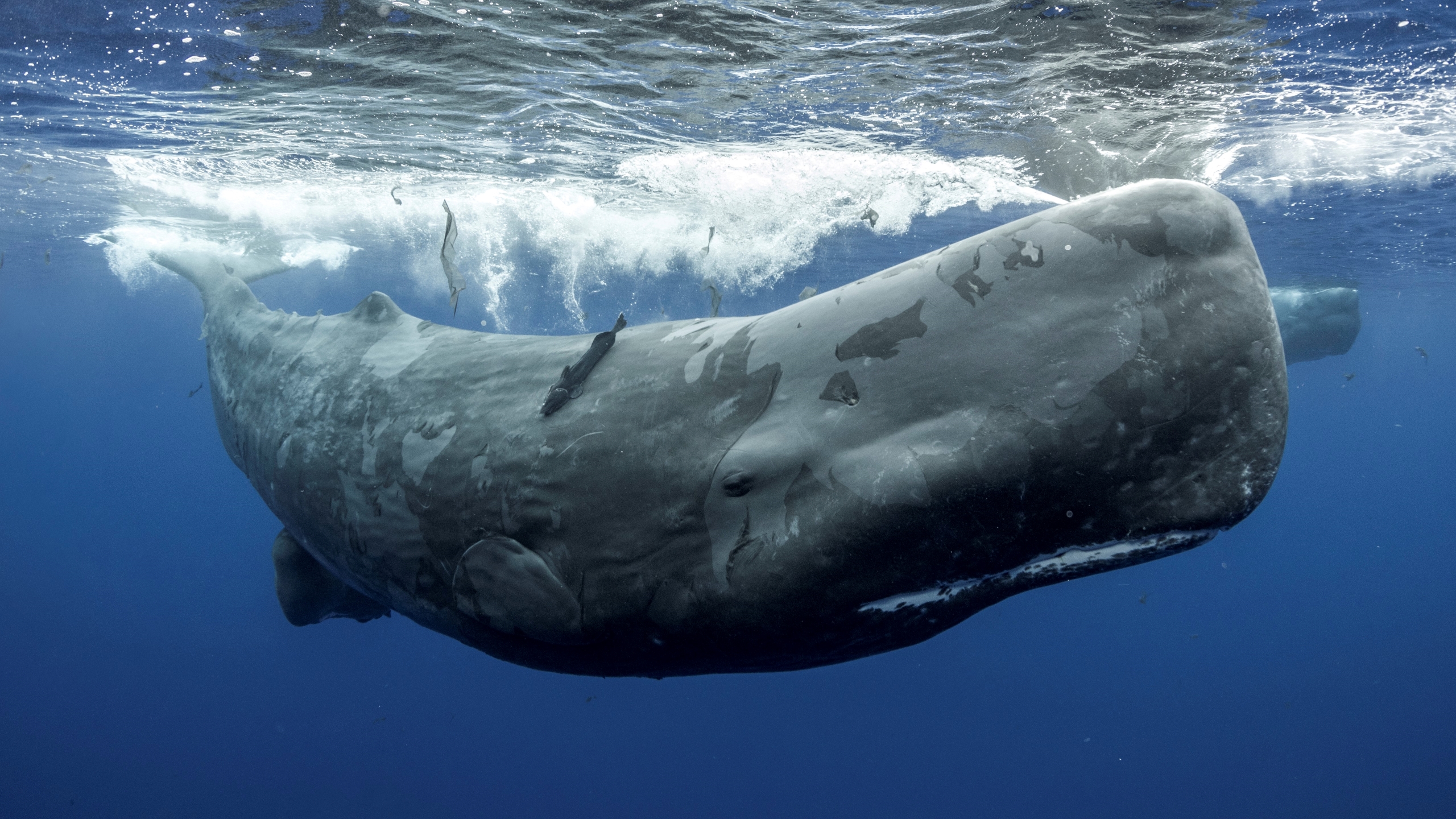
Sperm whales are the largest toothed whales, with a huge square head and the largest brain on Earth. These deep-sea divers are known for hunting giant squid and other prey at depths of 3 km below the surface of the sea.
Sperm whales are more closely related to dolphins than baleen whales, such as blue whales. According to the Zoological Society of London (ZSL), the name sperm whale comes from early whalers who mistaken the waxy oil found in the sperm whale's head organ for incense semen.
According to the National Oceanic and Atmospheric Administration (NOAA), sperm whales were hunted extensively in the 19th and 20th centuries for whale oil used in oil lamps and other products.
Whaling is now banned in most countries, and commercial trade has largely ceased. However, according to the International Union for Conservation of Nature (IUCN), sperm whale populations have not yet recovered from whaling and they are still vulnerable to extinction.
Male sperm whales can grow up to 18 meters and weigh up to 62.8 tons. According to wildlife charity Whale and Dolphin Conservation (WDC), females are smaller, reaching up to 11 meters long and weighing up to 16.5 tons.
The head of a sperm whale makes up about a third of its entire body. Whales have a distinctive, narrow jaw that contains all of their teeth. The teeth of sperm whales are tapered, and each tooth can reach 20 cm long and weigh 1 kg.
According to the IUCN, sperm whales live in oceans around the world, and their geographic range covers almost all ocean waters that are not covered by ice at depths of more than 1,000 meters.
Age, sex, food availability, and other factors influence where sperm whales live and travel, but their migration is not as predictable or well understood as other whale species. According to the National Oceanic and Atmospheric Administration (NOAA), adult males may make long-distance migrations to colder waters at both poles for a better source of food, while females and their offspring stay in warm tropical waters all year round.
A herd of sperm whales swims off the coast of the Azores in San Miguel.
Sperm whales are gregarious animals that communicate with each other with a range of sounds, including clicks and whistles. They usually live in groups of about 30, but the group size varies, with some individuals living alone. The most common group types are young children, made up of adult females and their minor children, and single groups, made up of sexually inactive males. According to research by the University of Michigan's Animal Diversity Network (ADW), adult males usually live alone.
Migrating mature males usually return to tropical waters in the spring to mate with females. After mating, females have a gestation period of 14 to 16 months before giving birth to a cub. According to the Norwegian Polar Institute, baby whales drink their mother's milk for the first 12 months of life, but also begin to eat solid foods, such as squid.
Female sperm whales mature sexually at ages 8 to 11. According to ADW, males may reach sexual maturity around the age of 10, but they have not yet reached high enough social status to mate before their 20s. According to the Norwegian Polar Research Institute, scientists do not know the exact lifespan of sperm whales, but there is evidence that sperm whales can live to be in their 70s.
According to the journal Life Science, sperm whales snooze in a vertical position by diving into the water, turning around, and hanging their tails, sleeping for about 10 to 15 minutes at a time, while they slowly resurfaced. According to a 2008 study published in the journal Contemporary Biology, they spend only 7 percent of their time in this inactive state, which is shorter than any other mammal's sleep time. The study documented this unusual sleep behavior for the first time.
A group of sperm whales is asleep.
According to the WDC, sperm whales can dive up to 3 kilometers underwater and hold their breath for two hours while searching for prey. They mainly eat squid, octopus, sharks and other deep-sea animals, especially giant squid. According to the American Museum of Natural History, these giant invertebrates fight whales and leave scars on them.
Sperm whales are not usually a threat to humans, but there are some historical records and stories of sperm whales attacking whaling ships. The whale mentioned in Herman Melville's 1851 novel Moby Dick was named after a real-life aggressive sperm whale named Mocha Dick. The male sperm whale, suffering from albinism, first appeared near the Chilean island of Mocha in South America. According to BBC News, the beluga whale allegedly attacked the whaling ship and killed its crew until 1838, when whalers succeeded in killing it.
An injured giant squid attacked by a sperm whale floats in the water.
The International Union for Conservation of Nature believes that sperm whales are vulnerable to extinction, but after a 2008 assessment, experts were unsure whether sperm whale populations were increasing, decreasing or stabilizing. Scientists roughly estimate that there were about 1.1 million whales in 1700, and by the 1990s, whale populations had fallen by 67 percent to 360,000 due to whaling. Large-scale commercial whaling stopped around 1980, but it's unclear whether sperm whale populations are increasing or still decreasing.
According to ZSL, Japan is the only country that is still hunting sperm whales.
According to the IUCN, sperm whales also face other human threats, such as being entangled in fishing gear, being hit by boats and contaminated. According to the National Oceanic and Atmospheric Administration, whales are on the U.S. Endangered Species List and are protected by the Marine Mammal Protection Act.